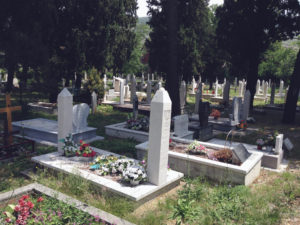(Part two of a three-part series)
By Dan Ebener
Note: The following article is based on conversations with friends in Croatia, Bosnia and Serbia. Part I of this series described how the religious divides in Croatia had less to do with religious practices and more to do with national identity. This article looks at Mostar, a city of 100,000 that is historically Croat but currently a part of Bosnia.

A Muslim cemetery in Mostar, Bosnia
The largest city in the Herzegovina section of what is now Bosnia, Mostar was at the forefront of what we called the Bosnian War in 1992. For three years, Croats, Bosnians and Serbs fought a bitter war over territorial divides that were usually described as religious.
Mostar provides a window in which we can view much of what is happening in this part of the world. Croat Catholics are a majority in their city but a minority in their country. In Mostar, Muslims are 35 percent of the population, Orthodox are 10 percent and Catholics are 55 percent. In Bosnia, the religious mix is 45 percent Muslim, 30 percent Orthodox and 25 percent Catholic.
Stumbling upon a tiny Mostar cemetery, I realized that every tombstone was marked during the same six-month period of 1992. My friends told me the cemetery was a park during the war, and that the tombs were originally dug at night by family members using silverware.
Twenty years after the Bosnian War, the signs of division are still evident in Mostar: shellacked buildings still bear the scars from the war. Many Muslims hold strictly to their side of town while Catholics do the same. Inter-religious friendships and partnerships are very awkward. Religious vandalism is common.
Dating and marrying across religions is almost unthinkable. Yet facially, it is almost impossible to distinguish Muslims from Catholics. History teaches us that most are relatives to each other across these religious lines. Five centuries ago, when the Turks brought Islam to Bosnia, families were divided. Some converted and some remained Catholic.
But they were still brothers, sisters and cousins to each other. Distinctions cannot be made except occasionally for clothing, food or religious custom. Yet relatively few are practicing their religion. They look alike. The best way to know the “religious” identity is by last name.
Walking across the famous Stone Bridge of Mostar, I offered to take a picture for a Muslim family dressed in traditional garb. After pausing to take in the view at the very top of the bridge, the mom, dad and three children walked back to the Muslim side. Watching more closely, I noticed other people who entered from either the Catholic or the Muslim side of the bridge walked to the top and then returned to the same side of the bridge. My friends said this was common. Crossing to the other side of town is unthinkable.
Croats in Bosnia identify more with Croatia than Bosnia. If you are a Croat football (soccer) player, good enough to play in the World Cup, you would play for Croatia, not Bosnia. Croat football (soccer) fans in Mostar root for Croatia, even though they live in Bosnia. It’s all about national identity, not the current national boundary lines.
Imagine fighting a bitter war waged on religious identity and now trying to live together in peace. Imagine trying to run a government with a religious mix like this. In Mostar, the mayor has a two-year term. The office has to be rotated every two years between a Bosnian Muslim and a Croat Catholic. Protections against religious discrimination have been written into many laws.
Yet the religious competition between Muslims and Catholics rages on in Mostar. In my next segment, I will describe how the divisions play out in the religious institutions. I will also provide a ray of hope for peace in the future of this part of the world.
(Dan Ebener teaches at St. Ambrose University and serves as diocesan director of Stewardship and Parish Planning.)








